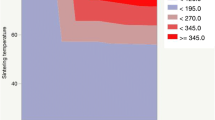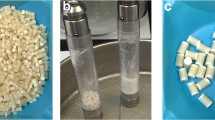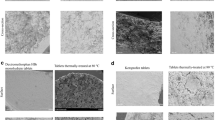Abstract
Polyethylene oxide (PEO) is a widely used polymer in the development of abuse-deterrent oral formulations. Different manufacturing processes including direct compression (DC) followed by sintering, wet granulation (WG) followed by compression and sintering, and hot melt extrusion (HME) can be used to manufacture abuse-deterrent oral drug products. Three different manufacturing processes (DC, WG, HME) were evaluated to test the retention of their abuse-deterrent features following attempts to grind the tablets or extrudates. In vitro drug release studies were conducted on 10% and 32% drug-loaded tablets/extrudates prepared using these manufacturing methods, and the release profiles from all formulations showed good extended-release properties. Drug content analysis on the granules obtained from tablets prepared by direct compression showed non-uniform drug distribution where an unexpectedly high drug content was present in the smallest size (< 250 µm) granules, sizes which are likely to be inhaled by abusers. Granules from tablets prepared by wet granulation showed improved drug distribution across all granule sizes formed after grinding. Drug content testing on the granules obtained from extrudates prepared using hot melt extrusion showed excellent drug content uniformity along with sufficient strength to resist grinding into smaller particles. The retention of the abuse-deterrent properties of a dosage form following attempts to extract or abuse the drug is an important product characteristic, and the product design, formulation components, and manufacturing processes can all play critical roles in the retention of the desired abuse-deterrent properties.





Similar content being viewed by others
References
Florence C, Luo F, Xu L, Zhou C. The economic burden of prescription opioid overdose, abuse and dependence in the United States, 2013. Med Care. 2016;54(10):901.
16 NJ. What classes of prescription drugs are commonly misused?. Retrieved from https://www.drugabuse.gov/publications/research-reports/misuse-prescription-drugs/what-classes-prescription-drugs-are-commonly-misused. 2020.
Manchikanti L, Singh A. Therapeutic opioids: a ten-year perspective on the complexities and complications of the escalating use, abuse, and nonmedical use of opioids. Pain Phys. 2008;11(2 Suppl):S63-88.
CDC/NCHS. National Vital Statistics System, Mortality. CDC WONDER https://www.cdc.gov/drugoverdose/images/data/OpioidDeathsByTypeUS.PNG, Atlanta, GA: US Department of Health and Human Services, CDC; 2018 [Available from: https://wonder.cdc.gov.
Raffa RB, Pergolizzi JV. Opioid formulations designed to resist/deter abuse. Drugs. 2010;70(13):1657–75.
Katz N, Dart RC, Bailey E, Trudeau J, Osgood E, Paillard F. Tampering with prescription Opioids: nature and extent of the problem, health consequences, and solutions. Am J Drug Alcohol Abuse. 2011;37(4):205–17.
Maincent J, Zhang F. Recent advances in abuse-deterrent technologies for the delivery of opioids. Int J Pharm. 2016;510(1):57–72.
Mastropietro DJ, Omidian H. Abuse-deterrent formulations: Part 2: Commercial products and proprietary technologies. Expert Opin Pharmacother. 2015;16(3):305–23.
Muppalaneni S, Mastropietro DJ, Omidian H. Crush resistance and insufflation potential of poly(ethylene oxide)-based abuse deterrent formulations. Expert Opin Drug Deliv. 2016;13(10):1375–82.
General principles for evaluating the abuse deterrence of generic solid oral opioid drug products - guidance for industry. [12/13/20]. Available from: https://www.fda.gov/media/96643/download.
Abuse-deterrent opioids — evaluation and labeling guidance for industry. [12/13/2020]. Available from: https://www.fda.gov/files/drugs/published/Abuse-Deterrent-OpioidsEvaluation-and-Labeling.pdf.
Meruva S, Donovan MD. Polyethylene Oxide (PEO) Molecular weight effects on abuse-deterrent properties of matrix tablets. AAPS PharmSciTech. 2019;21(1):28.
Rahman Z, Zidan AS, Korang-Yeboah M, Yang Y, Siddiqui A, Shakleya D, et al. Effects of excipients and curing process on the abuse deterrent properties of directly compressed tablets. Int J Pharm. 2017;517(1–2):303–11.
Rahman Z, Yang Y, Korang-Yeboah M, Siddiqui A, Xu X, Ashraf M, et al. Assessing impact of formulation and process variables on in-vitro performance of directly compressed abuse deterrent formulations. Int J Pharm. 2016;502(1):138–50.
Ma L, Deng L, Chen J. Applications of poly(ethylene oxide) in controlled release tablet systems: a review. Drug Dev Ind Pharm. 2014;40(7):845–51.
Nijenhuis A, Colstee E, Grijpma D, Pennings A. High molecular weight poly (L-lactide) and poly (ethylene oxide) blends: thermal characterization and physical properties. Polymer. 1996;37(26):5849–57.
Körner A, Larsson A, Andersson Å, Piculell L. Swelling and polymer erosion for poly (ethylene oxide) tablets of different molecular weights polydispersities. J Pharm Sci. 2010;99(3):1225–38.
Harland RS, Gazzaniga A, Sangalli ME, Colombo P, Peppas NA. Drug/polymer matrix swelling and dissolution. Pharm Res. 1988;5(8):488–94.
Borgquist P, Körner A, Piculell L, Larsson A, Axelsson A. A model for the drug release from a polymer matrix tablet—effects of swelling and dissolution. J Control Release. 2006;113(3):216–25.
Kim CJ. Effects of drug solubility, drug loading, and polymer molecular weight on drug release from Polyox tablets. Drug Dev Ind Pharm. 1998;24(7):645–51.
Meruva S, Donovan MD. Effects of drug-polymer interactions on tablet properties during the development of abuse-deterrent dosage forms. AAPS PharmSciTech. 2019;20(3):93.
Tan L, Carella AJ, Ren Y, Lo JB. Process optimization for continuous extrusion wet granulation. Pharm Dev Technol. 2011;16(4):302–15.
Bandelin FJ. Compressed tablets by wet granulation. Pharmaceutical dosage forms: tablets. 1989;1:131–93.
Kristensen HG, Schaefer T. Granulation: A review on pharmaceutical wet-granulation. Drug Dev Ind Pharm. 1987;13(4–5):803–72.
Becker D, Rigassi T, Bauer-Brandl A. Effectiveness of binders in wet granulation: a comparison using model formulations of different tabletability. Drug Dev Ind Pharm. 1997;23(8):791–808.
Vandevivere L, Denduyver P, Portier C, Häusler O, De Beer T, Vervaet C, et al. Influence of binder attributes on binder effectiveness in a continuous twin screw wet granulation process via wet and dry binder addition. Int J Pharm. 2020;585:119466.
Chitu TM, Oulahna D, Hemati M. Wet granulation in laboratory scale high shear mixers: Effect of binder properties. Powder Technol. 2011;206(1–2):25–33.
Chokshi R, Zia H. Hot-melt extrusion technique: a review. 2004.
Douroumis D. Hot-melt extrusion: Pharmaceutical applications: Wiley Online Library; 2012.
Desai D, Sandhu H, Shah N, Malick W, Zia H, Phuapradit W, et al. Selection of solid-state plasticizers as processing aids for hot-melt extrusion. J Pharm Sci. 2018;107(1):372–9.
Meruva S, Rezaei L, Thool P, Donovan MD. Use of drug release testing to evaluate the retention of abuse-deterrent properties of polyethylene oxide matrix tablets. AAPS PharmSciTech. 2020;21(7):270.
Ervasti T, Niinikoski H, Mäki-Lohiluoma E, Leppinen H, Ketolainen J, Korhonen O, et al. The comparison of two challenging low dose APIs in a continuous direct compression process. Pharmaceutics. 2020;12(3):279.
Kikura-Hanajiri R, Kawamura M, Miyajima A, Sunouchi M, Goda Y. Chiral analyses of dextromethorphan/levomethorphan and their metabolites in rat and human samples using LC-MS/MS. Anal Bioanal Chem. 2011;400(1):165–74.
Xu X, Siddiqui A, Srinivasan C, Mohammad A, Rahman Z, Korang-Yeboah M, et al. Evaluation of abuse-deterrent characteristics of tablets prepared via hot-melt extrusion. AAPS PharmSciTech. 2019;20(6):230.
White JL. Twin screw extrusion: Citeseer; 1993.
Butreddy A, Sarabu S, Dumpa N, Bandari S, Repka MA. Extended release pellets prepared by hot melt extrusion technique for abuse deterrent potential: category-1 in-vitro evaluation. Int J Pharm. 2020;587:119624.
Feng X, Vo A, Patil H, Tiwari RV, Alshetaili AS, Pimparade MB, et al. The effects of polymer carrier, hot melt extrusion process and downstream processing parameters on the moisture sorption properties of amorphous solid dispersions. J Pharm Pharmacol. 2016;68(5):692–704.
Shah VP, Tsong Y, Sathe P, Williams RL. Dissolution profile comparison using similarity factor, f2. Dissolution Technol. 1999;6(3):15.
Khan J, Dalu R, Gadekar S. Defects in extrusion process and their impact on product quality. Int J Mech Eng Robotics Res. 2014;3(3):187.
Boyce H, Smith D, Byrn S, Saluja B, Qu W, Gurvich VJ, et al. In Vitro assessment of nasal insufflation of comminuted drug products designed as abuse deterrent using the vertical diffusion cell. AAPS PharmSciTech. 2018;19(4):1744–57.
German RM. Sintering theory and practice1996.
Bartholomäus J, Schwier S, Brett M, Stahlberg H, Galia E, Strothmann K. New abuse deterrent formulation (ADF) technology for immediate-release opioids. Drug Dev Deliv. 2013;13(8):76–81.
Shangraw RF. Compressed tablets by direct compression. Pharm Dosage Forms Tablets. 1989;1:195–246.
Meng Z, Boyce HJ, Sun D, Kinjo M, Raofi S, Li T. Preferential oxycodone loss of physically manipulated abuse deterrent oxycodone hcl extended release tablets prepared for nasal insufflation studies. Pharm Res. 2021:1–16.
Shanmugam S. Granulation techniques and technologies: recent progresses. Bioimpacts. 2015;5(1):55–63.
Sarraf AG, Cherkaoui S, Jordan O, Gurny R, Doelker E. Controlled drug release from melt-extrudates through processing parameters: a chemometric approach. Int J Pharm. 2015;481(1):9–17.
Author information
Authors and Affiliations
Contributions
All of the authors participated in the writing and editing of this manuscript. L.R. was responsible for experimental execution and data analysis. S.M. was involved in conceptualization of the studies, experimental design, and data analysis. M.D.D. was responsible for conceptualization of the studies, overall direction of the research, and communication of the results.
Corresponding author
Ethics declarations
Conflict of Interest
There are no potential conflicts of interest and no competing financial interests for any of the authors.
Additional information
Publisher's Note
Springer Nature remains neutral with regard to jurisdictional claims in published maps and institutional affiliations.
Rights and permissions
About this article
Cite this article
Rezaei, L., Meruva, S. & Donovan, M.D. Effect of Manufacturing Process on the Retention of Abuse-Deterrent Properties of PEO-Matrix Tablets. AAPS PharmSciTech 23, 38 (2022). https://doi.org/10.1208/s12249-021-02169-6
Received:
Accepted:
Published:
DOI: https://doi.org/10.1208/s12249-021-02169-6




